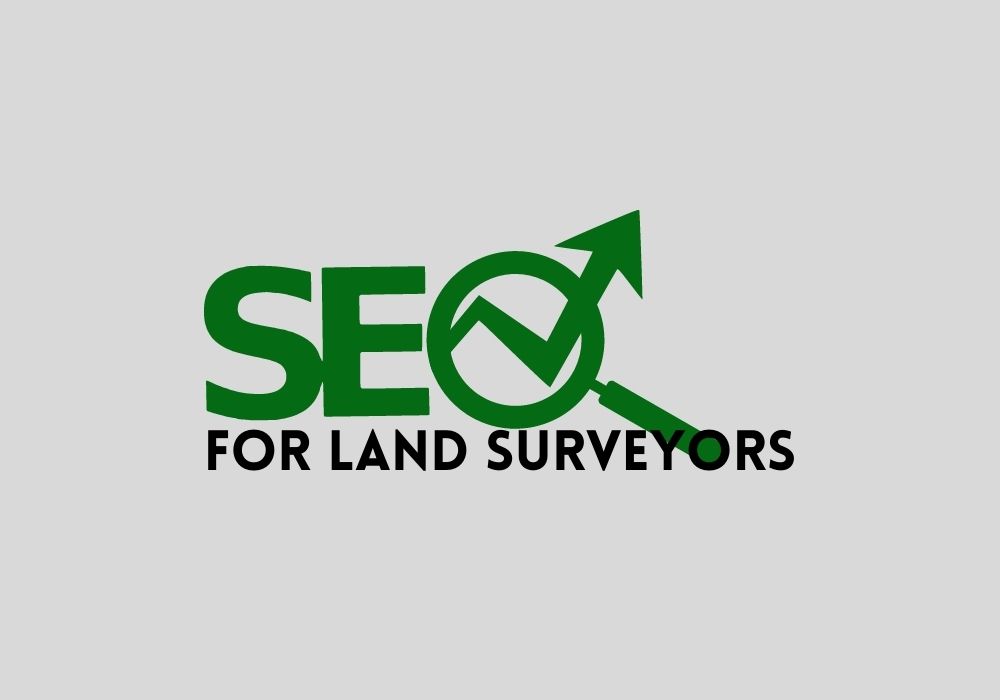It doesn’t matter how good you are at surveying, how many different services you offer and how competitive your pricing is, it’s all for nothing if no one can find you.
Enter SEO – Search Engine Optimisation.
To have a properly optimised website that search engines will want to show you must address the following:
- Website & URL structure,
- Keyword research,
- Image optimisation,
- Structured data,
- Internal links & External links, and
- Citations (geographic, business and local).
What Is SEO
Search Engine Optimisation or SEO is the process or steps taken to improve a website so it appears for search terms or keywords that people type into search engines such as Google and Bing.
How Does SEO Work?
When a search is done in Google or Bing, the results are pulled from their index of website pages.
Search engines have “spiders” which go out and crawl the web, these spiders collect information like:
- Inbound and outbound links to a site,
- Internal links within a site,
- Words on the pages, and
- Images and image meta information on the page.
This “crawled” information from the web pages is then put in an index and is analysed by the search engines algorithms, taking into account the many ranking factors or signals which determines which order pages appear in the SERP (search engine results page).
The ranking factors and signals are designed to return the most authoritative and relevant pages in the SERP. Having an optimised website for key search terms is necessary to being found on the internet.
Why Is SEO Important For Surveying Companies
People use search engines to answer questions. Questions like surveyors near me, surveyor ‘& town’, how much does a survey cost, subdivision surveyor.
SEO is optimising a webpage to appear for the search terms that your ideal client is searching for. Once a webpage content is optimised and ranking in the organic search results for a search term, any clicks you get to your page are free.
Over 90% of all global searches are done on Google. Because of that, it’s the search engine that you should focus on and optimise for.
Source: StatCounter Global Stats – Search Engine Market Share
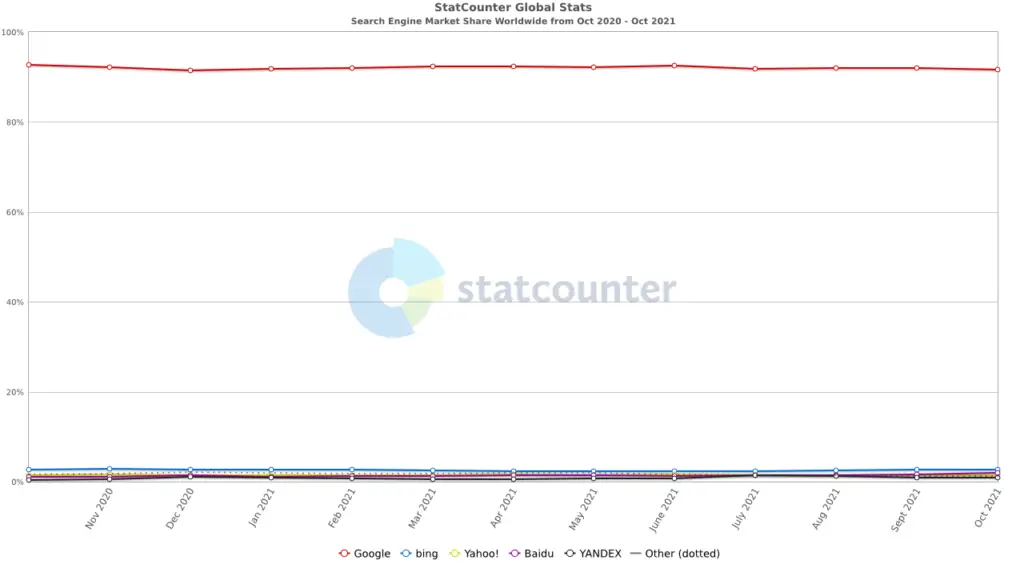
What Is The SERP
The SERP (search engine results page) is the page that is generated by a search engine when a user hits enter on a search.
Google’s SERP for a local surveyor search will usually look like the following:
- Relevant ads (usually 1 – 3 of the top positions)
- Map pack (sometimes with an ad at the top of the map pack),
- SERP feature (questions around hiring a local surveying firm),
- Organic search results,
- Relevant ads (usually 1 to 3 over the bottom positions), and then
- A related searches section.

Local businesses have an opportunity to appear in three spots in the SERP for free.
- In the Map Pack (also called the 3 Pack, Snack Pack or Local Pack)
- The SERP feature answering a frequently asked question, and
- In the organic listing results.
This is why SEO is important to surveying companies because with a properly optimised website and other web properties you could appear on the first page of Google 3 times, without having to pay Google a cent.
Why You Want Your Surveying Company To Rank On Page 1 For Local Search
The majority of searchers don’t go past the first three organic listings on the first page of Google, with over 50% of all clicks going to the top three results, and only 2.5% of clicks going to the last listing on the first page.
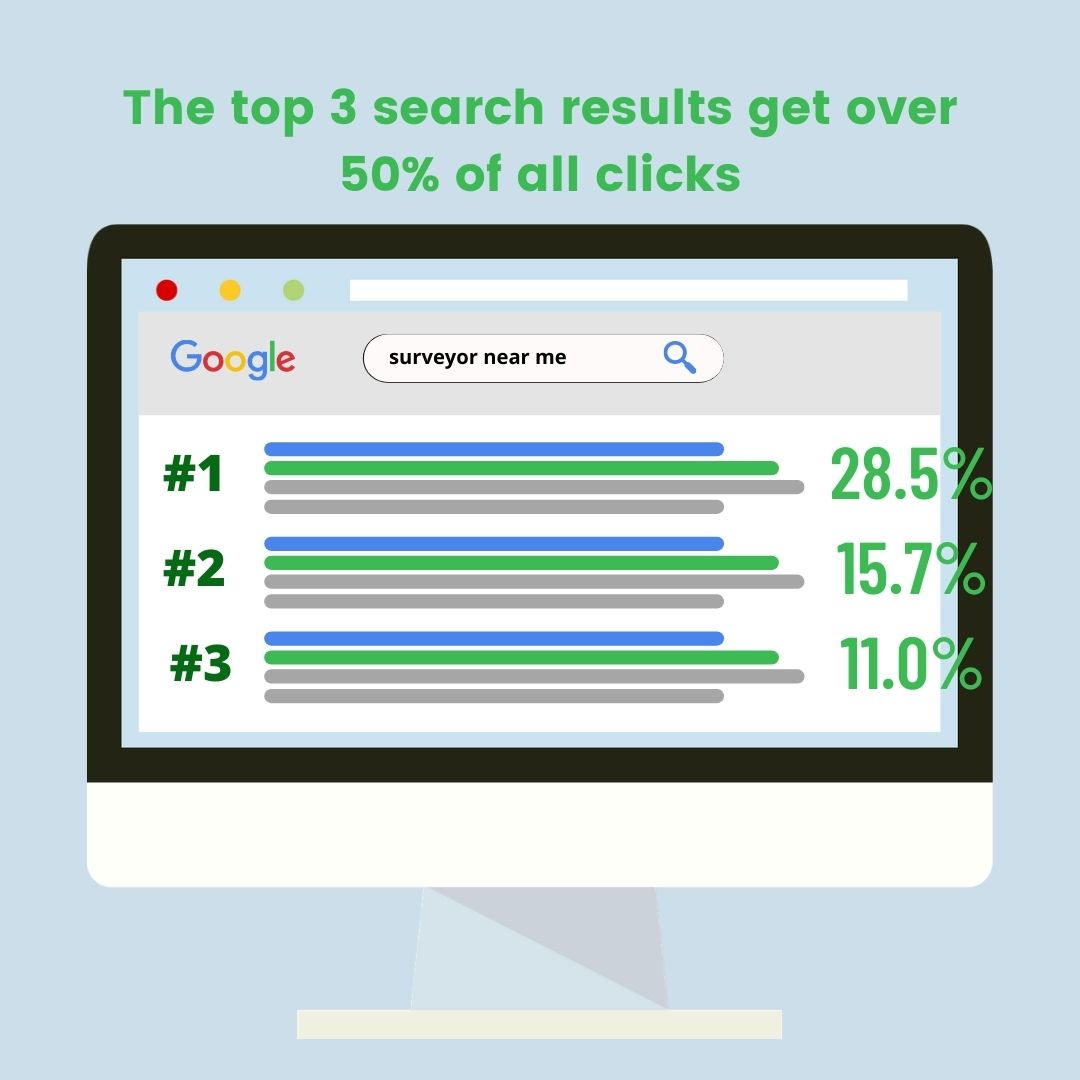
Source: Search Engine Journal
Also that less than 1% of all searchers even end up on the second page of Google. As the saying goes, the best place to hide a dead body is page 2 of Google.
Now we understand why SEO is important, let’s cover what ranking factors can actually influence the position a companies webpage ends up on the SERP.
Ranking Factors
There are three main ranking factors that will contribute to your business appearing on the first pages of the SERP.
- Local Ranking
- Relevancy
- Backlinks
Local Rankings
There is a help article on Google Business Profile that explains how Google settle their local rankings. They are:
- Relevance,
- Distance, and
- Prominence.
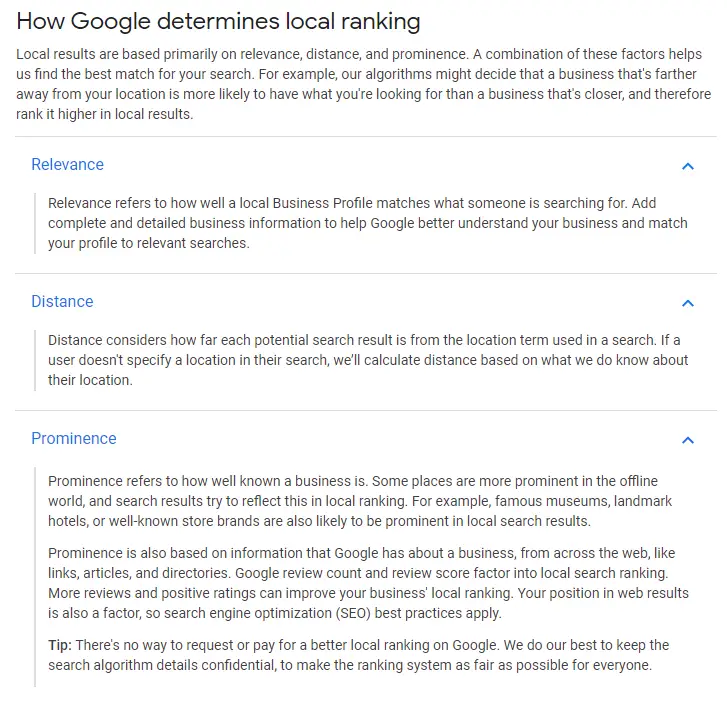
Source: Google
Relevance refers to how well a business matches up to what the searcher is searching for, i.e. does the business offer the service that is being searched for?
Distance is how far the business is located away from the person searching. The further away from the searcher the less likely that your business will be shown.
Prominence is how well the business is known for its services. Things such as links, reviews and positive ratings can improve a businesses prominence.
Relevancy
This is where the content on your website or other web properties (Google Business Profile) need to match up with what the searcher intent it. Have you created contextually relevant content that gives Google a good signal that you are the best result to show?
Completing keyword research, and creating content for your keyword lists should be the first thing you do when wanting to improve your local ranking results.
Relevant links:
Backlinks
In the early days of SEO, backlinks to websites were the most important way to rank on page 1 of Google. They were pretty much the only ranking factor that SEO professionals focused on. This lead to a lot of spam backlinks being generated on the internet.
As search engines like Google have been evolving, they have gotten better at evaluating not just the quality of the backlink (does it come from a reputable source), but also a range of other ranking factors which have decreased the importance of backlinks as a ranking signal.
They however are still an important enough ranking factor that you cannot ignore them altogether.
Website Optimisation For Surveyors
The main web properties for a service business today is their website and their Google Business Profile listing.
Both need to be optimised to increase the chance that they will appear in the first page of Google’s SERP and the local map pack.
In this blog we are only going to cover search engine optimisation for your surveying website. Our article on how to best optimise and setup your Google Business Profile will be linked here once published.
Website Structure
The structure of a website is critical if you will show up when a potential customer searches for your services in Google, particularly in competitive towns.
When Google’s “spiders” crawl a website they are collecting information about the words, images, inbound and outbound links to that page to understand what it is about. The best way you can help Google understand your page is to give it a single focus, i.e. a page must focus on only a single keyword to make it as easy as possible for Google (and other search engines) to understand it.
This means that it is best if you don’t put all of your services on a single page. Doing this makes your page not as clear to Google what it is about.
To have clear and focused web pages, your site structure may look like the below:
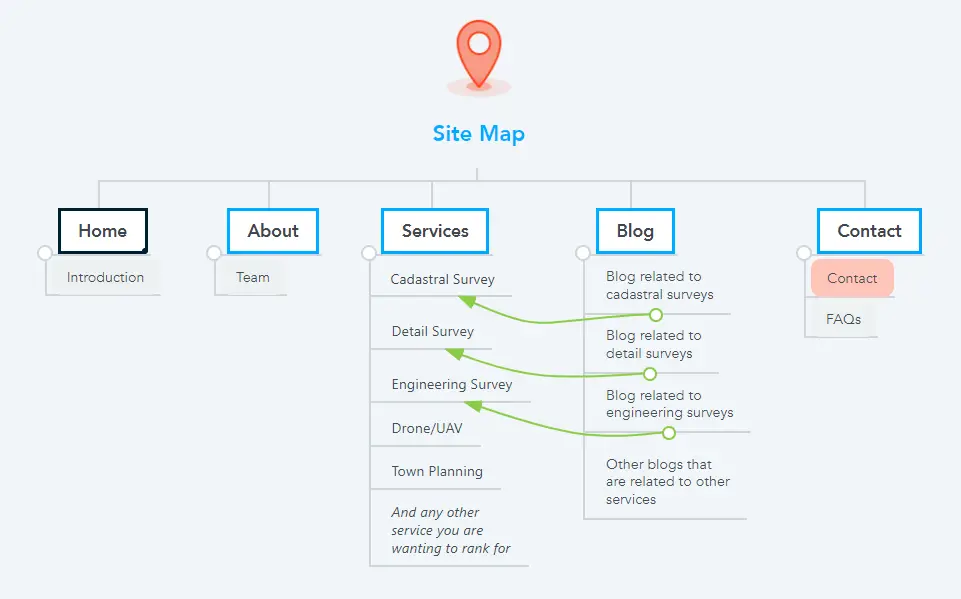
The benefits of laying your site out like in the above image is that it is clear to Google what each service landing page is about (focuses on just a single keyword + location), and each service landing page is being supported by a blog post linking to it which will help Google’s algorithm further understand what the page is about.
The below image shows the keywords that each landing page would be targeting for a Perth based surveying company.
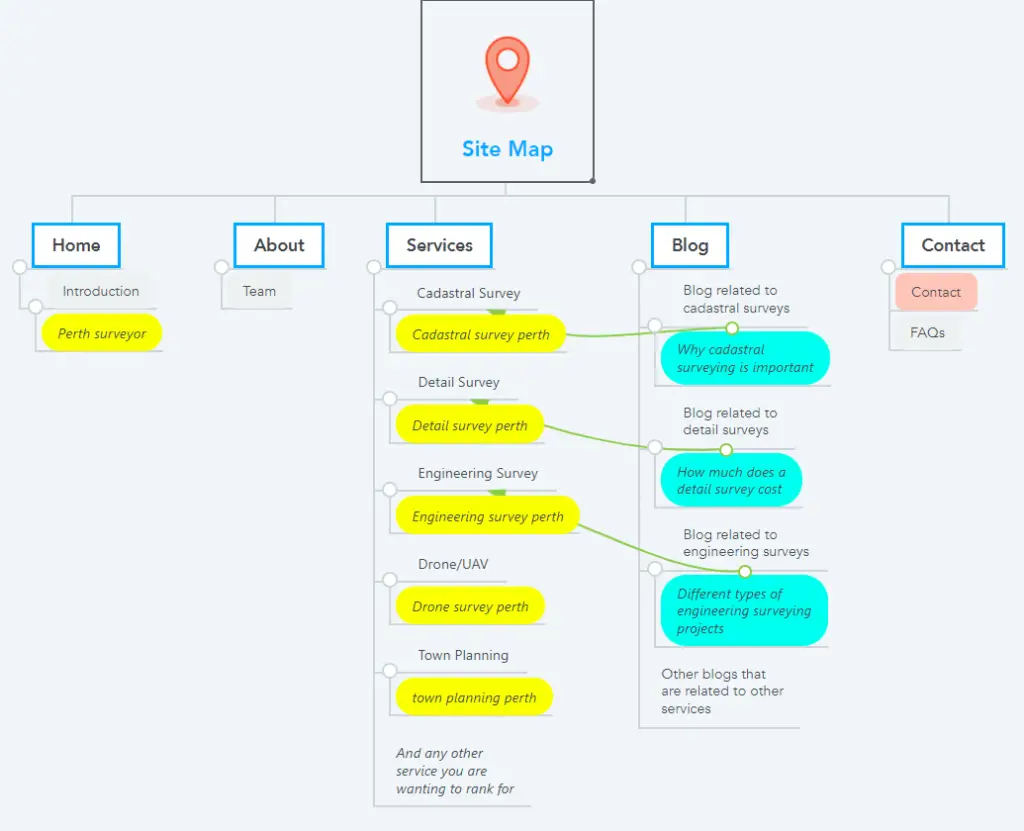
If your site is setup as above you will immediately put yourself in front of most of your competitors, and if you site content is properly optimised targeting the keyword + location you will undoubtedly find yourself on the first page of Google.
URL Structure
When creating your webpages it is also important that the URL of each page be named properly. This is just another element that search engines will consider when determining rankings.
So for example for ABC Surveyors website, the URL for their detail survey page will be abcsurveyors.com.au/detail-survey.
Keyword Research
Keyword research is initially straight forward for a surveying website. The website is wanting to show up for the services they offer in the location that they are. If you were a surveyor offering drone survey services in Los Angeles, you would build a page targeting the keyword “drone survey Los Angeles”.
However, once the basic pages have been built out, you can start doing some keyword research to find more ideas of what would be good content to write on your website as either a blog post, an FAQ or another service page.
There are lots of free tools to use to do this:
- https://answerthepublic.com/
- https://neilpatel.com/ubersuggest/
- https://keywordseverywhere.com/ (which has a plugin for the chrone and firefox browsers)
- https://alsoasked.com/
The purpose of doing this is to rank for more keywords that your ideal clients are searching for. For example, you may be a surveying company based in Melbourne, and ideally, you will show up for the keyword Melbourne surveyor. Keying in this seed keyword into alsoasked.com shows other queries that you could target in a blog post.
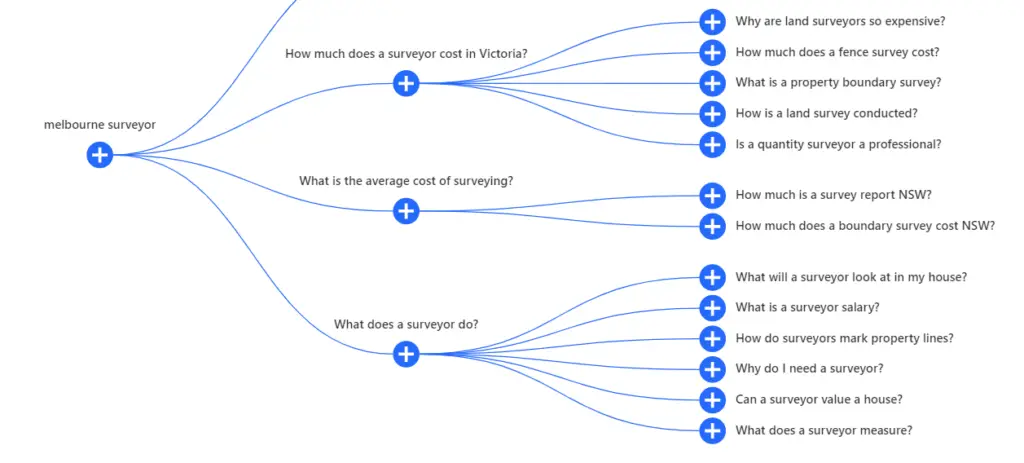
You could write a blog titled What Does A Surveyor Do? or Why Do I Need A Surveyor? You could then do an internal link from these blog posts to your home page and other service pages. Adding relevant internal links helps the search engines navigate your website and covering relevant topics will make your website appear more authoritative.
All of the above will help your website rise in the rankings.
On Page SEO
To help your website be more relevant to the searches intent, there are other things that you can optimise other than just the words on the page. They are:
Image Optimisation
To properly optimise images to be used on a website do the following:
- Reduce the image size as small as possible. This will help your pages load faster which will improve the user experience. You can use a free tool like https://shortpixel.com/ to reduce the image file size by over 50% in most cases, or if you are using wordpress you can use the Shortpixel or Smush plugin to do the same.
- Use real photographs of you and your team where possible, this helps build trust with your potential client. When a website is filled with stock photography it does nothing for trust and a potential client is more likely to bounce off your website.
- When uploading images make sure you fill out the Alt Text and Title fields. This is a great and easy way to fit in more keywords on your page and explain more to search engines what your page is about (see image below).
- Don’t over do your page with too many images. Images are good to help show your business and expertise off, but too may image slows down the loading time for web pages which increases the bounce rate of potential clients.
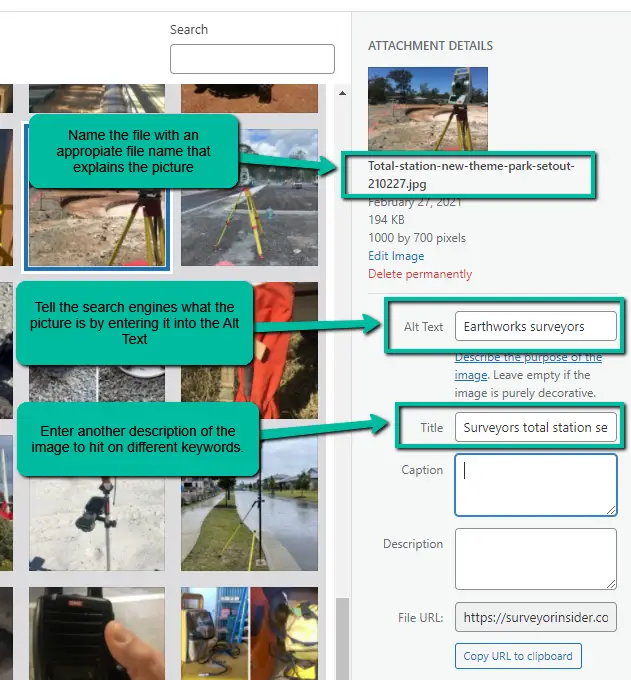
Local Structured Data
Structured data is a way of describing your site to make it easier for search engines to understand.
Yoast
As a minimum, you will want local structured data inserted into your website headers. The easy way to do this is to use a plugin. The free version of Rankmath can do this for you, there are probably other plugins that can also do it for free.
Having local structured data on your site makes clear the following information about your business to search engines:
- Address
- Latitude and longitude,
- Logo and icon image file,
- Type of business,
- Opening hours,
- Cost ($, $$, $$$, $$$$), and
- Website and phone number.
Embed Google Business Profile Map
If you only build one citation for your business, make a Google Business Profile. Once you have done this you can embed a map with your business location pinned. This will do two things:
- Create a nice map on your website that potential clients can use to identify where you are located, and
- Provide a clear connection to Google and other search engines that your website and Google Business Profile are for the same business and are one in the same.
To embed a Google Business Profile map on your website, simply go to maps.google.com and search for your business name. Then do the following:
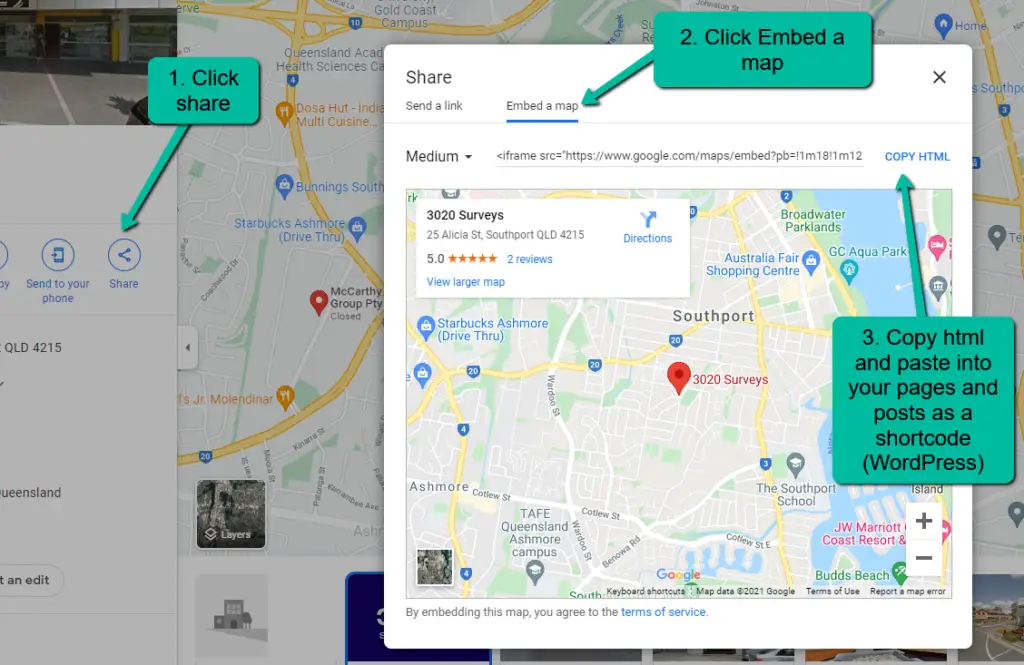
Website Audit
The two free tools that you can use to audit your website are:
Siteliner
Siteliner helps identify internal issues on your website such are duplicate content, broken links, large images slowing down your site, page speed and many other ones.
Copyscape
This tool will check your website for plagiarised content. Plagiarised content is a red flag for search engines not to rank your website. If you are writing all of your own content then you would know if it’s original or not. If you are getting someone else to write your website it would be a good idea to check that they just haven’t copied another site.
How To Index Your Website In Search Engines
There are two main search engines that you should register your website on, they are Google and Bing. To add your website to be indexed by both of these search engines click the below links and follow the instructions.
For WordPress users, Google has an app called Google Site Kit which can be downloaded for free which makes registering your site to be indexed by Google very easily.
Link Building
There are two types of links for websites:
- Internal links, and
- External links.
Internal links are when you link between pieces of content on your website.
External links are when your website gets links from websites that are not your own.
Internal Links
Internal links are important to a website because they help search engines understand your website better. And when you have plenty of closely related content on your website that interlinks throughout your website, at least in Google’s eyes it makes you appear link you have topical authority and deserve to be ranked above other similar sites.
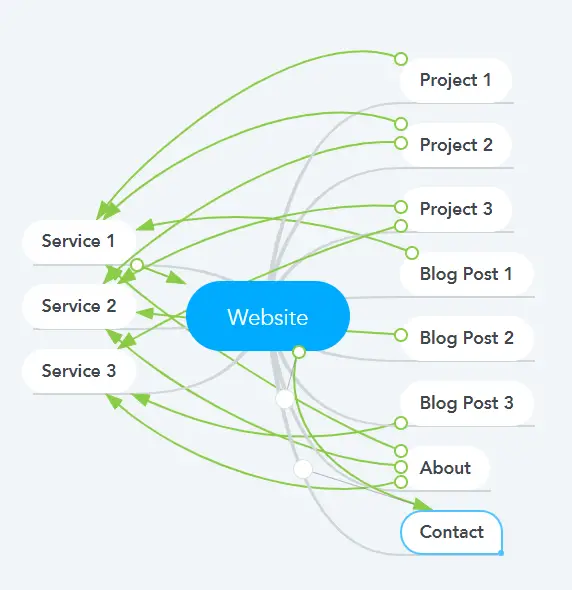
If you are a WordPress user there is a plugin called Link Whisper Free which can help you identify link opportunities.
External Links
In the early days of Google, their primary ranking factor was used to external links. The quality of the site linking didn’t matter, it was a numbers game and the one with the most links usually won.
Today, however, Google is much better at identifying the quality and relevance of the links. So it is important to do some link building to your website to help Google again understand your website.
Links can come from places including new websites, government websites, education institutions and many other places, these are typically harder links to get. So to start with it is best to get some quick links from citation services.
Citations
Geographic Citations
Geographic citations are where you can list where your business is on a map and are some of the strongest indicators for proximity, you should register your business at each of these:
- Google Business Profile
- Apple Maps
- Bing Places For Business
- Waze
Social Citations
It is important to increase your web footprint. You can do this by claiming your social media profiles.
- Linkedin Business
- Facebook Business Page
- Twitter (optional)
- Instagram (optional)
Business Listings
Once you are listed on the above map and social platforms you will need to register for any relevant business citation listing website. White Spark has already made a good list of quality citation websites that you can list your website on – their full list is here, and Call Rail have also made up their own list of important citations to get – their list is here.
Professional Body Links
Get your website mentioned and linked to from any organisation that operates within the land surveying industry in your country or state.
For Australia, a land surveying business would want to get a link from places such as SSSI.org.au, and if you can a link from state profession related bodies.
Free Citation Tool
Once you start getting several citations completed it becomes quite tricky to track and maintain all of your listing. The following tool will help check your citations for consistency (which is very important) and it free – Citation free scanner – https://www.brightlocal.com/free-local-seo-tools/local-listings-health-scanner/.
Final Thoughts
There is a lot of tasks to do that will help improve a land surveying company ranking in search engines. If you can keep at it and be continually improving your website and other web properties, you will be able to get your website to rank on the first page.

